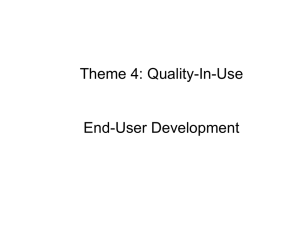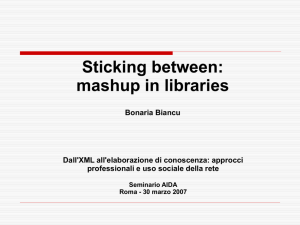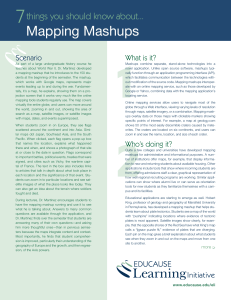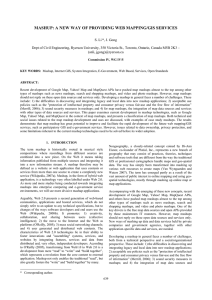Course: Multimedia Information Strategic Planning (MISP)
advertisement
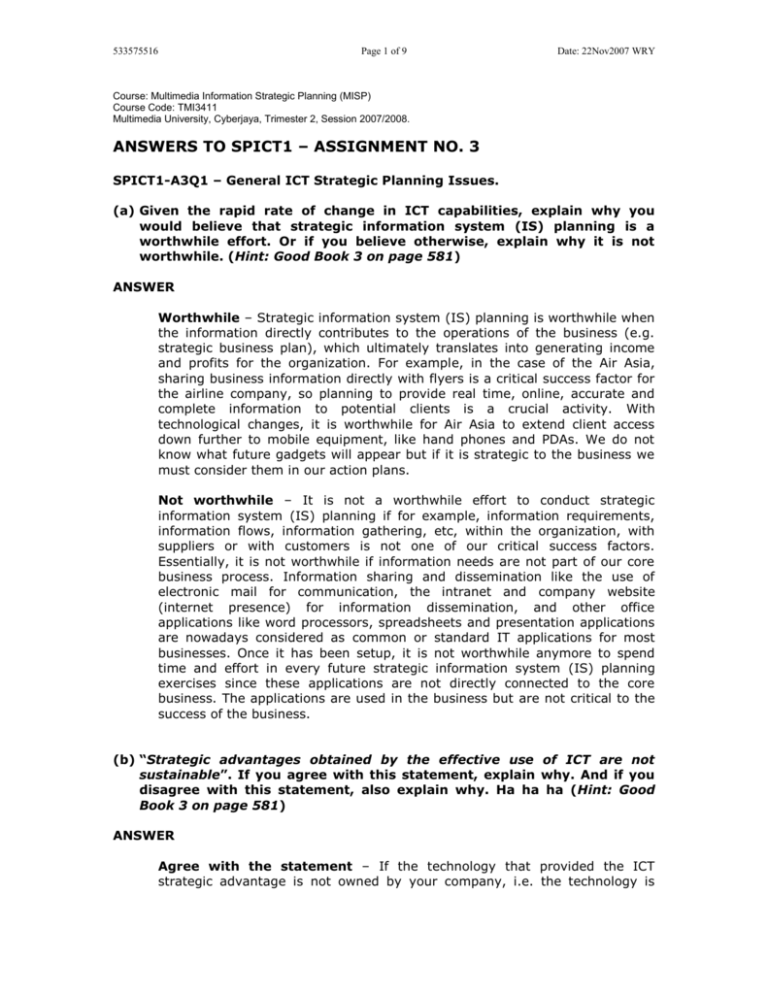
533575516 Page 1 of 9 Date: 22Nov2007 WRY Course: Multimedia Information Strategic Planning (MISP) Course Code: TMI3411 Multimedia University, Cyberjaya, Trimester 2, Session 2007/2008. ANSWERS TO SPICT1 – ASSIGNMENT NO. 3 SPICT1-A3Q1 – General ICT Strategic Planning Issues. (a) Given the rapid rate of change in ICT capabilities, explain why you would believe that strategic information system (IS) planning is a worthwhile effort. Or if you believe otherwise, explain why it is not worthwhile. (Hint: Good Book 3 on page 581) ANSWER Worthwhile – Strategic information system (IS) planning is worthwhile when the information directly contributes to the operations of the business (e.g. strategic business plan), which ultimately translates into generating income and profits for the organization. For example, in the case of the Air Asia, sharing business information directly with flyers is a critical success factor for the airline company, so planning to provide real time, online, accurate and complete information to potential clients is a crucial activity. With technological changes, it is worthwhile for Air Asia to extend client access down further to mobile equipment, like hand phones and PDAs. We do not know what future gadgets will appear but if it is strategic to the business we must consider them in our action plans. Not worthwhile – It is not a worthwhile effort to conduct strategic information system (IS) planning if for example, information requirements, information flows, information gathering, etc, within the organization, with suppliers or with customers is not one of our critical success factors. Essentially, it is not worthwhile if information needs are not part of our core business process. Information sharing and dissemination like the use of electronic mail for communication, the intranet and company website (internet presence) for information dissemination, and other office applications like word processors, spreadsheets and presentation applications are nowadays considered as common or standard IT applications for most businesses. Once it has been setup, it is not worthwhile anymore to spend time and effort in every future strategic information system (IS) planning exercises since these applications are not directly connected to the core business. The applications are used in the business but are not critical to the success of the business. (b) “Strategic advantages obtained by the effective use of ICT are not sustainable”. If you agree with this statement, explain why. And if you disagree with this statement, also explain why. Ha ha ha (Hint: Good Book 3 on page 581) ANSWER Agree with the statement – If the technology that provided the ICT strategic advantage is not owned by your company, i.e. the technology is 533575516 Page 2 of 9 Date: 22Nov2007 WRY owned by a third party, and is made available in the open market for other competitors to acquire (buy) and implement, then you cannot sustain the strategic advantage because it is a matter of time before others catch up with you and create an even playing field. Disagree with the statement – On the other hand, if the technology that provided the ICT strategic advantage is owned by your company and you have patented it (i.e. it is illegal for others to copy or use it, and you will not sell the related products and services to others), then you can sustain that strategic advantage up to the point until your patent expires, normally 15 years. After that it becomes an even playing field again. This patent concept is the protection of intellectual property for a specified period. In life, there is no intellectual property that you can claim ownership forever. (c) Explain why in most cases, the strategic ICT plan is driven by the strategic business plan and not the opposite? (Hint: Good Book 3 on page 581) ANSWER If ICT is not the core business of the company (e.g. you are in manufacturing and sales of non-ICT products), then it is the business that brings in the money to pay for salaries and every other expense of the company. It is common sense that the strategic ICT plan follow, is aligned to, or support the strategic business plan. This is the situation in most cases where the ICT department is one important part of the larger organization. On the other hand, if ICT is the core business of the company (i.e. you provide ICT products and services) then it is the strategic ICT plan that drives the strategic business plan. More often than not, the strategic ICT plan “merges” with the strategic business plan because in this special case “ICT is the business”. SPICT1-A3Q2 –Strategic Evaluation & Monitoring Tool – Balanced Scorecard. (a) In your own words, explain how the Balanced Scorecard (BSC) process is being used in strategic planning of ICT systems. You may illustrate using suitable examples. (Hints: Good Book 1, pages 204 and 214) ANSWER The Balanced Score Card (BSC) process is a strategy evaluation, monitoring and control technique. It is not a strategy formulation technique. The name BSC is derived from the perception of an organization’s need to “balance” financial measures, usually used exclusively in strategy evaluation, and control with non-financial measures such as product quality and customer service. The overall aim of BSC is to essentially balance the shareholder objectives with customer and operational objectives. 533575516 Page 3 of 9 Date: 22Nov2007 WRY For example, to manufacture a product of high quality you need high quality raw materials and high quality product designs. To achieve these two factors, you need to spend more money as high quality raw materials cost more and good product designers demand high salaries. You have therefore increased your overall cost of the product (the financial measure) at the same time you have increased your product quality (the internal business process measure). Now somebody must make the decision on how to “balance” these two opposite and inter-dependent issues – one is the increase in product quality (which is good) while the other is the increase in product cost (which is not good). The management must decide which way to go i.e. to consider the overall business objectives. Therefore, a strategy must be put in place to evaluate and control the balance between these two issues. The above is precisely how the BSC is being used in strategic planning together with strategic thinking and opportunistic decision making. (On this one, please refer to the answers to SPICT1 Assignment No. 1 Question No. 2 under Strategy versus Planning) Ensuing from these strategic business decisions, the ICT infrastructure and ICT strategic plan to support the new business operations must also be incorporated accordingly. (b)Describe the four (4) mandatory perspectives (i.e. the views or parameters of measure) of the Balanced Scorecard for an organization. ANSWER The four (4) mandatory perspectives of the Balanced Scorecard (BSC) for an organization are as follows: (1) Organization financial performance – e.g. data in numbers regarding profits generated, manufacturing costs and other factors like borrowings, loans, etc to run the business. (2) Customer perception – e.g. customers believe that our products are of high quality standards, meet their diverse needs, priced accordingly, etc. (3) Internal business process – e.g. efficient manufacturing process like 200 units per day output, energy cost RM 0.35 per unit, and equipment maintenance cost averaging RM 2.50 per unit, etc. These numbers reflect efficiency when compared to other manufacturers in the same business. (4) Internal learning and growth – e.g. the measure of human resource capabilities in the organization. The increase in skills, knowledge and competency for product engineering through research and development, competence in sales and marketing, the continuous learning programs implemented by the company for staff, etc. (c) Provide four (4) examples, i.e. one each for the four (4) perspectives of the Balanced Scorecard. Include in your examples, the KPI as the measurement statement, the targets, the weights and the scoring mechanisms. 533575516 Page 4 of 9 Date: 22Nov2007 WRY ANSWER The BSC table below provides one KPI example for each of the four (4) BSC perspectives with the set targets, set weights, scoring tables, actual scores and the total points achieved. BSC PERSPECTIVE and KPI 1 ACTUAL SCORE TOTAL POINTS 10% max 0.30 5% less = 10 (5 - 8)% = 8 (8 – 10)% =4 10% more =0 8 2.40 50 less = 0 (50 - 60) = 5 (60 – 80) = 7 80 more = 10 7 2.80 3% less = 10 (3 - 5)% = 8 (5 – 7)% = 4 (7 – 9)% = 2 9% more =0 4 1.00 2 2 4 5 2 0.60 0.30 0.7 min INTERNAL BUSINESS PROCESS KPI = Electricity cost percent of product total cost per unit 4 SCORING TABLE CUSTOMER PERCEPTION KPI = Product quality by customer survey for product A 3. SET WEIGHT 0.30 FINANCIAL PERFORMANCE KPI = Gearing ratio for operations (borrowings/assets) 2 SET TARGET 0.20 7% max LEARNING & GROWTH KPI = R & D to achieve number of new product models per year 0.40 0.25 0.20 5 models 0.30 less = 0 or 3 = 2 or 5 = 7 more = 10 (d)How do you calculate the individual performance index for each one of the four (4) perspectives? How do you calculate the overall performance index of the organization? ANSWER Normally, the number of KPIs for each BSC perspective is more than one. Each KPI will have its own set weight contribution, which must total up to 1.0 for each BSC perspective. The individual performance index for each perspective will be the sum of the total points achieved for that perspective. This is just like “one trimester GPA of study at MMU”. For the overall performance index of the organization, we must first establish the weight contributions of each of the four (4) BSC perspectives. In the example BSC table above, these weights are 0.30, 0.30, 0.20 and 0.20, respectively, and adds up to 1.0. The overall performance index is then the weighted sum of the individual performance indices using these weight values. This is like the “the single CGPA for a student at MMU” SPICT1-A3Q3 – Industry Analysis: External Factor Evaluation (EFE) Matrix 533575516 Page 5 of 9 Date: 22Nov2007 WRY (a) An External Factor Evaluation (EFE) Matrix allows strategists to summarize and evaluate what we call PEEST – the political, economic, environmental, social, technological, demographic, governmental, legal and competitive information. What are the five (5) steps in the development of an EFE matrix according to the author of Good Book 2, described on page 101? ANSWER (1) List the external factors as identified in the external-audit process covering both the opportunities and threats to the organization. (2) Assign to each factor a weight that ranges from 0.0 to 1.0, with a score that indicates the relative importance of that factor to contribute to the success of the organization. The higher weight is for the more important factor. The sum of all the weights must equal 1.0. (3) Assign a rating score (e.g. range from 0 to 10) to each external factor to indicate how effectively the organization’s current strategies respond to that factor. The higher rating is for the more effective strategy. (4) Multiply each factor’s weight by its rating to determine a weighted score. Since we used a rating range of 0 to 10, the maximum value of a weighted score is 10. (5) Sum the weighted scores for each variable to determine the total weighted score for the organization. By the same reasoning as item (4) above, the maximum value of a total weighted score is also 10. (b)In what way is the EFE matrix using the SWOT concept? Is EFE an extension or an enhancement of the SWOT process? (Hints: Study tables 3.7 and 3.8 carefully in Good Book 2, pages 102 and 103). ANSWER Essentially the EFE matrix is the “second half” of SWOT, specifically the analyses and evaluations of Opportunities (O) and Threats (T), for factors which are external to the organization. That is why the EFE is called the External Factor Evaluation. The EFE matrix can be called an extension of SWOT if your normal SWOT analysis does not include the weighting and rating assessments. It is not an extension if you have already included the weighting and rating assessments in your normal SWOT analysis. (c) What are the major differences between the EFE matrix and the IFE matrix? Is the IFE matrix also related to the SWOT process? If it is related, explain how. (Hint: Good Book 2 on page 147). ANSWER The IFE matrix is basically the “first half” of SWOT, specifically the analyses and evaluations of Strengths (W) and Weaknesses (W), for factors which are internal to the organization. That is why the IFE is called the Internal Factor Evaluation. 533575516 Page 6 of 9 Date: 22Nov2007 WRY Similarly, the IFE matrix can be called an extension of SWOT if your normal SWOT analysis does not include the weighting and rating assessments. It is not an extension if you have already included the weighting and rating assessments in your normal SWOT analysis. (d)In the IFE matrix referred in (c) above, what do they mean by the statement “Ratings are thus company-based, whereas the weights are industry-based.” ANSWER According to Good Book 2, a weight is an assignment of relative importance of the external factor to the success of the organization, while a rating is an assessment of the effectiveness of the strategy being implemented in response to the external factor. The “ratings are company-based” means that the company must make its own assessment on how effective its strategies are (i.e. self-evaluation), and there is nobody outside to help them on this. This makes sense because the company itself is the only one that can rate “what it believes” to be the effectiveness in the performance (i.e. achievement) of its strategies. On the other hand, “weights are industry-based” means that the relative importance of the external factors to the organization is similar to other companies that belong to the same industry (or market segment). This makes sense since every company is “open to the environment” that provides the same opportunities and threats. It is a matter of whether the company “sees” the opportunities and threats or it does not. SPICT1-A3Q4 – Mini Case: SPICT1-Assn-03-Q4-At-Mashup-Camp.pdf In this mini case titled “At Mashup Camp, geeks plot future of Web” answer the following three (3) questions: (a) Chris Radcliff said "This is taking the SOA idea and applying it to the mess that is the real world. You can grab pieces from here and there. It makes it a lot more informal, which increases adoption". Is this the idea of a mashup? ANSWER Yes. The above statement is really the idea of a mashup. In fact, the word mashup came from the words “messed up”. (b) According to the author of this article, Martin LaMonica, there is a major difference between a mashup and web services running on SOA (serviceoriented architecture). What is the difference? ANSWER 533575516 Page 7 of 9 Date: 22Nov2007 WRY A web service on SOA is a formal specification with strict rules that must be obeyed, built through highly structured and complex web architecture. The service oriented architecture (SOA) comprises a suite of Web services standards and infrastructure software built on a modular design. The application codes that serve this web service are normally large and powerful, and thus can at times be slow and sluggish. This web service queries data from various distributed sources, for example, data of the organization in its own internal network, and sometimes subscribed data (paid and licensed) on the internet from public and private sources (i.e. with permission). Most large corporate software run complex web services on the SOA following certain shared standards. Mashups also use the web service SOA idea described above, except that mashups are smaller, stripped-down, and lightweight web applications. Mashups are a lot more informal than a web service on SOA and at times do not follow strict communication rules. Mashups also pull together data from different sources on the internet, for example, weather information and product shipping information, etc, by querying for data from these different websites. Mashups sometimes grab data from websites without permission. Mashups in contrast to the web service on SOA, tend to focus on speed and simplicity, wiring together different Web sites using quick and lightweight methods. Because of the simplicity, lightweight and execution speed of mashups over web services on SOA, mashups are already gaining wide acceptance in the ICT world. This can be inferred from the statement in the article: "You see SOAs and Web services struggling to get critical mass (i.e. wide acceptance), and this lightweight programming model (i.e. mashup model) is already hitting critical mass." (c) Explain why mashup developers have a “fear of getting cut off”. ANSWER Mashups operate by grabbing pieces of information from here and there on or off the internet. A mashup application can be written such that it uses a Web site's API without prior permission to get whatever information it wants. This is contravening the law and has been said to be pushing the legal limits. Mashup developers have a “fear of getting cut off” means the developers feared that some of the current sources that allow mashups to query for data may shut off (shut down) access to the mashup applications. The reasons for cut off could be legal (e.g. must subscribe and pay for the data, or must be licensed, etc,) or the mashups had become serious commercial competitors, or the mashups had consumed too many resources, such as bandwidth, which slowed down the services or the original web services. Note: The “fear of cutoff” is real for mashups because their operations of freely grabbing pieces of information from here and there on and off the internet rely on the data provided by Web services providers. When data access is cutoff, mashups will not function anymore because they have no data on their own. Ha ha ha. 533575516 Page 8 of 9 Date: 22Nov2007 WRY SPICT1-A3Q5 – Mini Case: SPICT1-Assn-03-Q5-Business-Mashup-Enterprise2.0.pdf In this mini case we provided three (3) short and related articles listed below: (1) Business-Ready Mashup Platforms (2) Making use of the world-wide services cornucopia (3) The state of Enterprise 2.0 (a) With so much hype about “mashup”, what does mashup really offer business users according to Dion Hinchcliffe in the article Business-Ready Mashup Platforms? ANSWER According to Dion Hinchcliffe, his vision for what mashups can really offer business users is summarized in the statement: Mashups could theoretically allow business users to move — when appropriate — from their current so-called “end-user development tools” such as Microsoft Excel that are highly isolated and poorly integrated to much more deeply integrated models that are more Web-based and hence more open, collaborative, reusable, shareable, and in general make better use of existing sources of content and functionality. These tools could let thousands of workers solve their situational software integration problems on the spot themselves, instead of waiting (sometimes forever) for IT to provide a solution. (b) In the article titled Making use of the world-wide services cornucopia (i.e. abundance, large amount of available services), what does the author mean by the statement “that the blurriness between the boundaries of your systems and others - and your organization and others – will only increase over time”? ANSWER One of the premises of Enterprise Web 2.0 is that not only are these "re-mixing" techniques (i.e. mashups) valid and viable within the organization, but that the blurriness between the boundaries of your systems and others - and your organization and others – will only increase over time. The above statement means that in the long run, if you were to implement many little, lightweight mashups applications in your system, you will end up not being able to identify the boundaries of your own applications from others because there is so much “messing up” or “mashup” of your data coming from various sources; - and that is precisely the idea of a mashup - a web application that combines data from more than one source into a single integrated tool and relying on others to provide the data. The statement above uses the phrase “increase in blurriness of the boundary” which means “the decrease in sharpness of the boundary” to a point where we eventually cannot identify the boundary anymore. Ha ha ha. 533575516 Page 9 of 9 Date: 22Nov2007 WRY (c) What are the two (2) questions about the “State of Enterprise 2.0” to those companies that are not sure (undecided) about its successful adoption? ANSWER The two (2) big questions for many companies regarding their indecisiveness on the adoption of Enterprise 2.0 are: (1) Do we now have the right capabilities in terms of ready Enterprise 2.0 products? (2) Do we generally understand how to apply them properly to obtain good returns on our investment (ROI) in them? The companies believed that knowing the answers to both questions will almost certainly tell them if they were ready for mainstream adoption of Enterprise 2.0 any time soon. (d) Summarize the seven (7) lessons on Enterprise 2.0 with “just one sentence” for each lesson. It means that you put down seven bullet points, and each bullet point is just one sentence for each lesson. (Now you get to practice making bullet summaries that you liked so much. Ha ha ha.) ANSWER The following seven (7) lessons are what we’ve learned about “The state of Enterprise 2.0” up to this point of Fall 2007 (October 22nd, 2007): (1) Enterprise 2.0 is going to happen in your organization with you or without you. (2) Effective Enterprise 2.0 seems to involve more than just blogs and wikis. (3) Enterprise 2.0 is more a state of mind than a product you can purchase. (4) Most businesses still need to educate their workers on the techniques and best practices of Enterprise 2.0 and social media. (5) The benefits of Enterprise 2.0 can be dramatic, but only builds steadily over time. (6) Enterprise 2.0 doesn’t seem to put older IT systems out of business. (7) Your organization will begin to change in new ways because of Enterprise 2.0. Important: You must visit the websites below to see a real life Enterprise 2.0 being implemented and used in MMU, Cyberjaya for FIT students and staff. Register and join in the discussions. Ha ha ha. http://groups.google.com/group/fit-cafeteria http://groups.google.com/group/fit-cafeteria/browse_thread/thread/d57c1d00183716a5 http://groups.google.com/group/fit-cafeteria/browse_thread/thread/9029f9440e36ecd0
